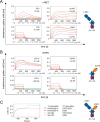Balancing Selectivity and Efficacy of Bispecific Epidermal Growth Factor Receptor (EGFR) × c-MET Antibodies and Antibody-Drug Conjugates
- PMID: 27694443
- PMCID: PMC5122778
- DOI: 10.1074/jbc.M116.753491
Balancing Selectivity and Efficacy of Bispecific Epidermal Growth Factor Receptor (EGFR) × c-MET Antibodies and Antibody-Drug Conjugates
Abstract
Bispecific antibodies (bsAbs) and antibody-drug conjugates (ADCs) have already demonstrated benefits for the treatment of cancer in several clinical studies, showing improved drug selectivity and efficacy. In particular, simultaneous targeting of prominent cancer antigens, such as EGF receptor (EGFR) and c-MET, by bsAbs has raised increasing interest for potentially circumventing receptor cross-talk and c-MET-mediated acquired resistance during anti-EGFR monotherapy. In this study, we combined the selectivity of EGFR × c-MET bsAbs with the potency of cytotoxic agents via bispecific antibody-toxin conjugation. Affinity-attenuated bispecific EGFR × c-MET antibody-drug conjugates demonstrated high in vitro selectivity toward tumor cells overexpressing both antigens and potent anti-tumor efficacy. Due to basal EGFR expression in the skin, ADCs targeting EGFR in general warrant early safety assessments. Reduction in EGFR affinity led to decreased toxicity in keratinocytes. Thus, the combination of bsAb affinity engineering with the concept of toxin conjugation may be a viable route to improve the safety profile of ADCs targeting ubiquitously expressed antigens.
Keywords: antibody engineering; anticancer drug; epidermal growth factor receptor (EGFR); sortase A; toxicity.
© 2016 by The American Society for Biochemistry and Molecular Biology, Inc.
Figures




Similar articles
-
Impact of Cell-surface Antigen Expression on Target Engagement and Function of an Epidermal Growth Factor Receptor × c-MET Bispecific Antibody.J Biol Chem. 2015 Oct 9;290(41):24689-704. doi: 10.1074/jbc.M115.651653. Epub 2015 Aug 10. J Biol Chem. 2015. PMID: 26260789 Free PMC article.
-
Discovery of amivantamab (JNJ-61186372), a bispecific antibody targeting EGFR and MET.J Biol Chem. 2021 Jan-Jun;296:100641. doi: 10.1016/j.jbc.2021.100641. Epub 2021 Apr 8. J Biol Chem. 2021. PMID: 33839159 Free PMC article.
-
Novel strategy for a bispecific antibody: induction of dual target internalization and degradation.Oncogene. 2016 Aug 25;35(34):4437-46. doi: 10.1038/onc.2015.514. Epub 2016 Feb 8. Oncogene. 2016. PMID: 26853467
-
Antibody-drug conjugates and bispecific antibodies targeting cancers: applications of click chemistry.Arch Pharm Res. 2023 Mar;46(3):131-148. doi: 10.1007/s12272-023-01433-6. Epub 2023 Mar 6. Arch Pharm Res. 2023. PMID: 36877356 Review.
-
Advances in bispecific biotherapeutics for the treatment of cancer.Biochem Pharmacol. 2012 Nov 1;84(9):1105-12. doi: 10.1016/j.bcp.2012.07.011. Epub 2012 Jul 25. Biochem Pharmacol. 2012. PMID: 22858161 Review.
Cited by
-
Engineering hydrophobicity and manufacturability for optimized biparatopic antibody-drug conjugates targeting c-MET.MAbs. 2024 Jan-Dec;16(1):2302386. doi: 10.1080/19420862.2024.2302386. Epub 2024 Jan 12. MAbs. 2024. PMID: 38214660 Free PMC article.
-
In Vivo Biorthogonal Antibody Click for Dual Targeting and Augmented Efficacy in Cancer Treatment.bioRxiv [Preprint]. 2023 Nov 6:2023.09.05.556426. doi: 10.1101/2023.09.05.556426. bioRxiv. 2023. PMID: 37986985 Free PMC article. Preprint.
-
Mechanisms of ADC Toxicity and Strategies to Increase ADC Tolerability.Cancers (Basel). 2023 Jan 24;15(3):713. doi: 10.3390/cancers15030713. Cancers (Basel). 2023. PMID: 36765668 Free PMC article. Review.
-
Advances in clinical research of MET exon 14 skipping mutations in non-small cell lung cancer.J Cancer Res Clin Oncol. 2025 Feb 12;151(2):78. doi: 10.1007/s00432-025-06115-y. J Cancer Res Clin Oncol. 2025. PMID: 39937291 Free PMC article. Review.
-
Progress of antibody-drug conjugates (ADCs) targeting c-Met in cancer therapy; insights from clinical and preclinical studies.Drug Deliv Transl Res. 2024 Nov;14(11):2963-2988. doi: 10.1007/s13346-024-01564-3. Epub 2024 Apr 10. Drug Deliv Transl Res. 2024. PMID: 38597995 Review.
References
-
- Holmes D. (2011) Buy buy bispecific antibodies. Nat. Rev. Drug Discov. 10, 798–800 - PubMed
-
- Kontermann R. E., and Brinkmann U. (2015) Bispecific antibodies. Drug Discov. Today 20, 838–847 - PubMed
-
- Garber K. (2014) Bispecific antibodies rise again. Nat. Rev. Drug Discov. 13, 799–801 - PubMed
-
- Jarantow S. W., Bushey B. S., Pardinas J. R., Boakye K., Lacy E. R., Sanders R., Sepulveda M. A., Moores S. L., and Chiu M. L. (2015) Impact of cell-surface antigen expression on target engagement and function of an epidermal growth factor receptor × c-MET bispecific antibody. J. Biol. Chem. 290, 24689–24704 - PMC - PubMed
MeSH terms
Substances
LinkOut - more resources
Full Text Sources
Other Literature Sources
Research Materials
Miscellaneous

